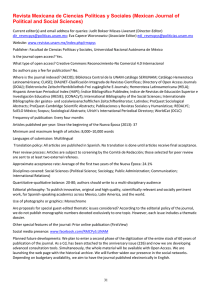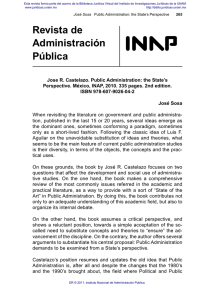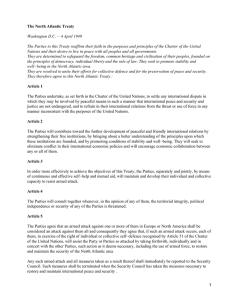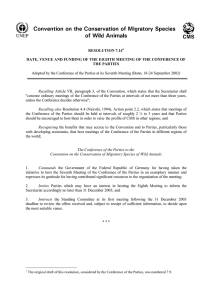master ARS
Anuncio
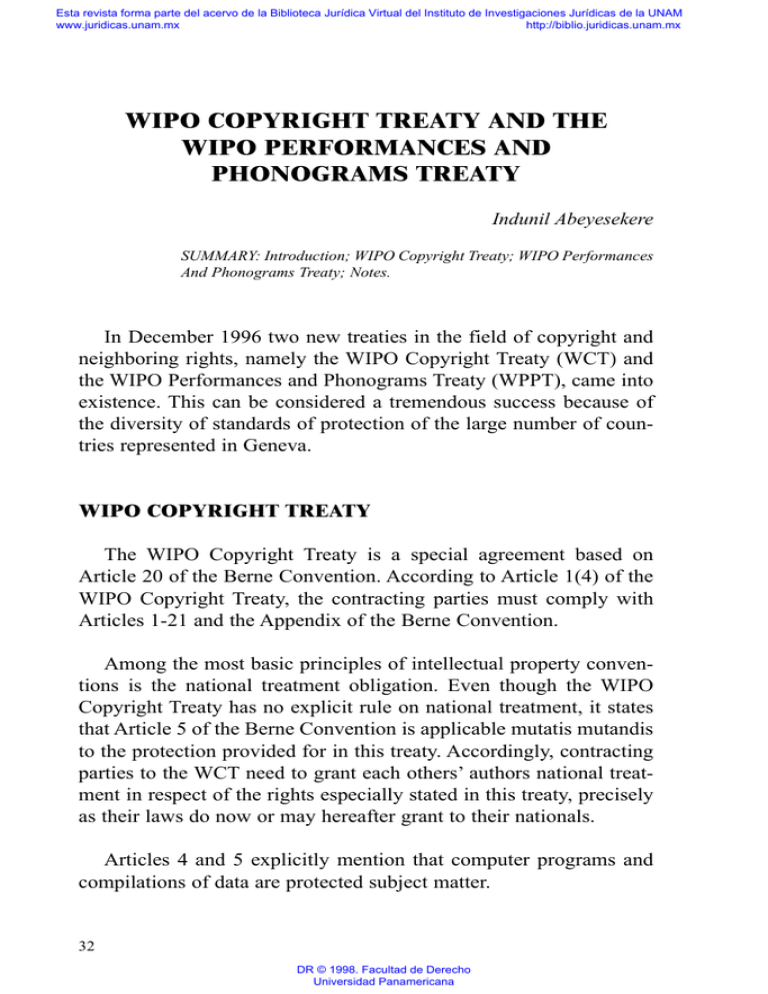
Esta revista forma parte del acervo de la Biblioteca Jurídica Virtual del Instituto de Investigaciones Jurídicas de la UNAM http://biblio.juridicas.unam.mx www.juridicas.unam.mx WIPO COPYRIGHT TREATY AND THE WIPO PERFORMANCES AND PHONOGRAMS TREATY Indunil Abeyesekere SUMMARY: Introduction; WIPO Copyright Treaty; WIPO Performances And Phonograms Treaty; Notes. In December 1996 two new treaties in the field of copyright and neighboring rights, namely the WIPO Copyright Treaty (WCT) and the WIPO Performances and Phonograms Treaty (WPPT), came into existence. This can be considered a tremendous success because of the diversity of standards of protection of the large number of countries represented in Geneva. WIPO COPYRIGHT TREATY The WIPO Copyright Treaty is a special agreement based on Article 20 of the Berne Convention. According to Article 1(4) of the WIPO Copyright Treaty, the contracting parties must comply with Articles 1-21 and the Appendix of the Berne Convention. Among the most basic principles of intellectual property conventions is the national treatment obligation. Even though the WIPO Copyright Treaty has no explicit rule on national treatment, it states that Article 5 of the Berne Convention is applicable mutatis mutandis to the protection provided for in this treaty. Accordingly, contracting parties to the WCT need to grant each others’ authors national treatment in respect of the rights especially stated in this treaty, precisely as their laws do now or may hereafter grant to their nationals. Articles 4 and 5 explicitly mention that computer programs and compilations of data are protected subject matter. 32 DR © 1998. Facultad de Derecho Universidad Panamericana Esta revista forma parte del acervo de la Biblioteca Jurídica Virtual del Instituto de Investigaciones Jurídicas de la UNAM http://biblio.juridicas.unam.mx www.juridicas.unam.mx INDUNIL ABEYESEKERE Clarifying the scope of the reproduction right was one of the most disputed areas. Since it is hard to describe the various forms of temporary reproduction and the circumstances in which it occurs, in a legal text, no provision on the reproduction right was adopted. The existing Article 9 of the Berne Convention was considered to be an appropriate basis to deal with any form of reproduction . Under Article 6 an exclusive right of distribution is provided to the authors, but the contracting parties have been given the burden of determining the conditions if any, under which exhaustion applies after the first sale/transfer of ownership of the original or a copy of the work being authorized by the author. Authors of computer programs, cinematographic works and works embodied in phonograms as determined in the national law of contracting parties are provided with the exclusive right of commercial rental. This article affords more clarity than that of Article 14(4) of the TRIPS Agreement: authors of all works embodied in phonograms be granted rights, where Article 14(4) of TRIPS refers only to «any other rightholder in phonograms» instead of «authors of works embodied in phonograms». One of the main achievements of the WCT is Article 8, which introduces the right to authorize on-line transmissions within the scope of a broad communication right. The first part of Article 8 provides a general right of communication to the public in the traditional sense for all authors, and the second part covers interactive situations such as on-demand transmissions. According to the second part of Article 8, the notion of public need not be defined, as the relevant act commences by making available for access, which follows invariably with respect to an open number of unrelated persons simultaneously. Article 10 of the WCT, which is similar to Article 13 of the TRIPS Agreement, deals with limitations and exceptions. The WCT unlike the Berne Convention does not indicate specific types of permitted limitations and exceptions but simply provides for a general principle. 33 DR © 1998. Facultad de Derecho Universidad Panamericana Esta revista forma parte del acervo de la Biblioteca Jurídica Virtual del Instituto de Investigaciones Jurídicas de la UNAM http://biblio.juridicas.unam.mx www.juridicas.unam.mx WIPO COPYRIGHT TREATY AND THE WIPO PERFORMANCES AND PHONOGRAMS TREATY Article 10(2) of the WCT could serve as a guideline for the correct definition and application of limitations and help to reinforce the level of protection in the new treaties on authors’ rights as in the Berne Convention. Furthermore, it enables flexibility for national legislators to adapt limitations and exceptions in the digital environment. Taking into consideration the increasingly important role played by technical measures to protect, identify and control works, Article 11 of the WCT has established obligations concerning technological measures. There had been lengthy debates at both national and international level on the right balance and scope of such a provision, which generally leaves a degree of flexibility for the contracting parties to choose in their domestic legislation the technological measures that should be protected, the types of sanctions that should be imposed and the concrete activities that should be targeted. By assuring that the sphere of application of the circumvention provision corresponds to that of copyright infringement, the WCT preserves the delicate copyright balance. Article 12 of the WCT deals with the obligation of contracting parties to provide adequate and effective legal remedies against the removal or alteration of electronic rights management information. Article 14 of the WCT requires the contracting parties to adapt, in accordance with their legal systems, the necessary measures to ensure the application of the treaties and establish that enforcement procedures are available under their law so as to permit effective action against any act of infringement of the rights covered by the treaties. The contracting parties must provide for expeditious remedies to prevent infringements, remedies which should constitute a deterrent to further infringements. The formulation of this provision is derived from the first part of Article 41 (1) of the TRIPS Agreement. WIPO PERFORMANCES AND PHONOGRAMS TREATY As compared to the Rome Convention and Article 14 of the TRIPS Agreement, the WIPO Performances and Phonograms Treaty has 34 DR © 1998. Facultad de Derecho Universidad Panamericana Esta revista forma parte del acervo de la Biblioteca Jurídica Virtual del Instituto de Investigaciones Jurídicas de la UNAM http://biblio.juridicas.unam.mx www.juridicas.unam.mx INDUNIL ABEYESEKERE achieved significant progress in relation to the rights of phonogram producers and audio performers. Performers and producers who are nationals of contracting states are eligible to receive protection in all member countries. Performers and phonogram producers who meet the criteria for eligibility for protection provided under the Rome Convention are entitled to protection under the WPPT. It must be noted that both the WCT and WPPT provide for the criterion of first publication. To ensure uniformity in application of this criterion to electronic publication, an attempt at clarification was made. However, no consensus was reached and the definition of publication remains open to diverse interpretation The right of distribution, rental, making available on-line transmission and limitations and exceptions are mainly drafted on the basis of the corresponding provisions of the WIPO Copyright Treaty. The reproduction right has to be specifically provided since the WPPT does not rely on any links to another convention such as provided for in Article 1(4) of the Copyright Treaty with respect to the Berne Convention. Furthermore, an exclusive right of making available is provided and other forms of communication are subject only to a remuneration right. Performers are provided with full exclusive rights regarding fixed and unfixed performances. In the context of moral rights, on the international level, this is the first instance that the right to be identified and the right of integrity of the performances are conferred on performers. This provision is based on Article 6bis of the Berne Convention. The provision in regard to technical protection, rights management information and enforcement are parallel to those of the Copyright Treaty. The issues of national treatment and the audio-visual coverage of the Performances and Phonograms Treaty were among the most controversial areas. Initially, the United States proposed a wide national treatment obligation for neighboring rights on the basis of Article 5 of the Berne Convention, whereas many delegations 35 DR © 1998. Facultad de Derecho Universidad Panamericana Esta revista forma parte del acervo de la Biblioteca Jurídica Virtual del Instituto de Investigaciones Jurídicas de la UNAM http://biblio.juridicas.unam.mx www.juridicas.unam.mx WIPO COPYRIGHT TREATY AND THE WIPO PERFORMANCES AND PHONOGRAMS TREATY insisted on a more limited clause as in the Rome Convention or in TRIPS. Finally, Article 4 (1) was adopted, which is similar to the Rome Convention and the TRIPS Agreement, by limiting the national treatment obligation to the exclusive rights specifically granted in this Treaty and to the right to equitable remuneration for broadcasting of communication to the public subject to Article 4 (2). Protecting audio-visual performances was subject to much debate but no consensus was reached. Many countries shared the view that audio-visual performances should be protected, since it is unnatural to make a distinction between sound and audio-visual performances. However, the US was in the forefront of opposition against the protection of audio-visual performances, owing to its particular circumstances in the film industry. Failing to reach a consensus on this issue, it was agreed to renew discussions and to adopt an audio-visual protocol to the WPPT before the end of 1998. Article 17 of the WPPT provides a minimum term of protection of 50 years for the economic rights granted under that treaty which is an improvement to the Rome Convention that grants only a minimum term of 20 years. The term of 50 years is justified on the basis of a longer commercial life of phonograms and fixed performances. The new treaties have no doubt added a unique dimension in enhancing a progressive and pragmatic rationale towards achieving a universally acceptable balance of rights. Notes: 1. LLB(Hons.), University of Colombo, Sri Lanka; M.I.P., Franklin Pierce Law Center, Concord, USA; Lecturer, University of Colombo; Aftorney-at-law, Sri Lanka. 2. The Governments of the countries of the Union reserved the right to enter into special agreements among themselves, in so far as such agreements grant to authors more extensive rights than those granted by the Convention, or contained other provisions 36 DR © 1998. Facultad de Derecho Universidad Panamericana Esta revista forma parte del acervo de la Biblioteca Jurídica Virtual del Instituto de Investigaciones Jurídicas de la UNAM http://biblio.juridicas.unam.mx www.juridicas.unam.mx INDUNIL ABEYESEKERE not contrary to this Convention. The provisions of existing agreements which satisfy these conditions shall remain applicable. 3. Silke von Lewinski, WIPO Diplomatic Conference Results in Two New Treaties, IIC NO-2/1997 at p.205. 4. Agreed Statement concerning Article 1(4) of the WIPO Copyright Treaty. 5. Article 7. 6. Silke von Lewinski, WIPO Diplomatic Conference Results in Two New Treaties, IIC No-2/1997 at p.205. 7. Reinbothe, Martin-Prat, and von Lewinski, The New WIPO Treaties: A First Resume, [199714 EIPR 173. 8. Ibid. at p. 173. 9. Vijnje, The New WIPO Copyright Treaty: A Happy Result in Geneva, [1997] 5 EIPR 235. 10. Reinbothe, Martin-Prat, and von Lewinski, The New WIPO Treaties: A First Resume, [199714 EIPR 172. 11. Article 15. 12. The obligation provided for in Article 4(1) does not apply to the extent that another contracting party makes use of the reservations permitted by Article 15(3) of WPPT. 37 DR © 1998. Facultad de Derecho Universidad Panamericana


